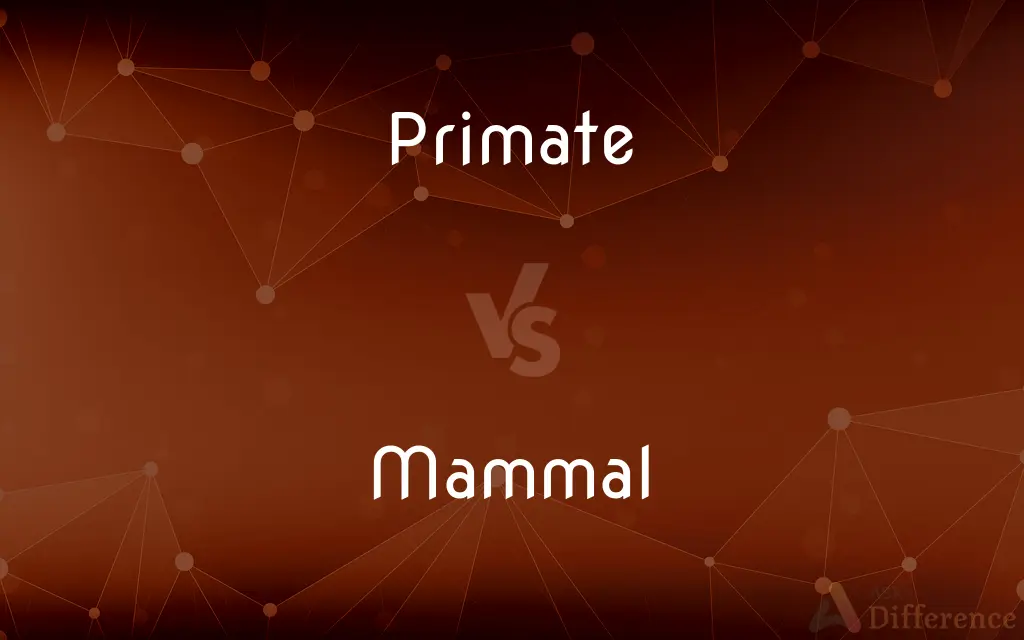Primate vs. Mammal — What's the Difference?
By Urooj Arif & Fiza Rafique — Updated on April 16, 2024
Primates are a specific order of mammals, including humans and monkeys, characterized by larger brains and complex behaviors, while mammals encompass a broader range of animals with fur and mammary glands.

Difference Between Primate and Mammal
Table of Contents
ADVERTISEMENT
Key Differences
Primates are an order within the class Mammalia, known for their advanced cognitive abilities and social structures. Mammals, encompassing a much larger group, are defined by characteristics such as mammary glands, which females use to nurse their young. Primates share these traits but are distinguished by their larger brains and reliance on sight more than smell.
Primates generally have more complex brains and greater behavioral flexibility compared to other mammals. Mammals as a group vary widely in brain size and complexity, ranging from the relatively simple brains of rodents to the highly complex brains of dolphins.
In terms of reproduction, primates tend to have longer gestation periods and fewer offspring, focusing on intensive parental care. On the other hand, mammals can have a variety of reproductive strategies, from the large litters of rodents to the single-calf births typical of whales.
Primates usually exhibit significant use of hands for manipulation, possessing opposable thumbs in many species. Whereas other mammals may use other body parts for manipulation or may not manipulate their environment much at all, like cetaceans or ungulates.
Social structures in primates are highly varied and complex, often involving intricate communication systems and hierarchies. Other mammals also display social behaviors, but these can range from the solitary lifestyles of bears to the complex societal structures of elephants and wolves.
ADVERTISEMENT
Comparison Chart
Definition
Order of mammals with advanced brain structures and social systems.
Class of vertebrates with hair and mammary glands.
Brain Complexity
Generally more complex, facilitating advanced problem solving and social interaction.
Varies widely, from simple to complex across species.
Reproduction
Longer gestation periods, fewer offspring, intensive care.
Wide range, from many small offspring to fewer, well-cared-for young.
Physical Manipulation
Frequent use of hands, often with opposable thumbs.
Varies, ranging from minimal physical manipulation to use of various body parts.
Social Structures
Highly complex, with intricate communication and hierarchies.
Ranges from solitary to complex social groups, depending on species.
Compare with Definitions
Primate
Primates often have opposable thumbs, aiding in tool use and food handling.
Humans use their opposable thumbs to manipulate objects finely.
Mammal
Any of a class of warm-blooded vertebrate animals that have, in the female, mammary glands producing milk.
Cows are mammals that provide milk for human consumption.
Primate
Primate social systems are complex, involving various forms of communication and social bonds.
Gorillas have tight-knit family groups led by a silverback.
Mammal
Reproductive strategies in mammals vary widely, from placental development to marsupial pouches.
Kangaroos give birth to undeveloped joeys that continue growing in a pouch.
Primate
Any member of the order of animals distinguished by highly developed brains, forward-facing eyes, and complex behaviors.
Chimpanzees are primates known for their social interactions.
Mammal
Many mammals are known for their ability to adapt to various environments, from aquatic to terrestrial.
Dolphins are mammals adapted to living fully in water.
Primate
Typically have longer developmental periods compared to other mammals, emphasizing learning and parental care.
Young orangutans stay with their mothers for many years learning survival skills.
Mammal
Mammals are characterized by the presence of hair or fur, which serves various functions including insulation.
Polar bears have thick fur to protect against cold climates.
Primate
Characterized by reliance on visual acuity over olfactory cues.
Primates such as humans have reduced olfactory abilities but enhanced vision.
Mammal
Social structures in mammals can vary from solitary to complex hierarchies, such as those observed in wolf packs.
Wolves live and hunt in packs, exhibiting complex social behaviors.
Primate
A primate ( (listen) PRY-mayt) (from Latin primat-, from primus 'prime, first rank') is a eutherian mammal constituting the taxonomic order Primates (). Primates arose 85–55 million years ago first from small terrestrial mammals, which adapted to living in the trees of tropical forests: many primate characteristics represent adaptations to life in this challenging environment, including large brains, visual acuity, color vision, a shoulder girdle allowing a large degree of movement in the shoulder joint, and dextrous hands.
Mammal
Any of various warm-blooded vertebrate animals of the class Mammalia, including humans, characterized by a covering of hair on the skin and, in the female, milk-producing mammary glands for nourishing the young.
Primate
(prīmāt′) Any of various mammals of the order Primates, which consists of the lemurs, lorises, tarsiers, New World monkeys, Old World monkeys, and apes including humans, and is characterized by nails on the hands and feet, a short snout, and a large brain.
Mammal
An animal of the class Mammalia, characterized by being warm-blooded, having hair and producing milk with which to feed its young.
Primate
A bishop of highest rank in a province or country.
Mammal
(paleontology) A vertebrate with three bones in the inner ear and one in the jaw.
Primate
(zoology) A mammal of the order Primates, including simians and prosimians.
Primates range from lemurs to gorillas.
Mammal
One of the Mammalia.
Primate
(informal) A simian anthropoid; an ape, human or monkey.
Mammal
Any warm-blooded vertebrate having the skin more or less covered with hair; young are born alive except for the small subclass of monotremes and nourished with milk
Primate
(ecclesiastical) In the Catholic Church, a rare title conferred to or claimed by the sees of certain archbishops, or the highest-ranking bishop of a present or historical, usually political circumscription.
Primate
(ecclesiastical) In the Orthodox Church, the presiding bishop of an ecclesiastical jurisdiction or region. Usually, the expression primate refers to the first hierarch of an autocephalous or autonomous Orthodox church. Less often, it is used to refer to the ruling bishop of an archdiocese or diocese.
Primate
(ecclesiastical) In the Anglican Church, an archbishop, or the highest-ranking bishop of an ecclesiastic province.
Primate
The chief ecclesiastic in a national church; one who presides over other bishops in a province; an archbishop.
Primate
One of the Primates.
Primate
A senior clergyman and dignitary
Primate
Any placental mammal of the order Primates; has good eyesight and flexible hands and feet
Common Curiosities
Do all mammals have live births?
Most mammals have live births, but there are exceptions like the monotremes (platypus and echidna) which lay eggs.
How do the diets of primates differ from other mammals?
Primates often have varied diets including fruits, leaves, insects, and in some cases, meat, while other mammals can have more specialized diets.
What role does the opposable thumb play in the life of a primate?
The opposable thumb allows primates to grasp objects and manipulate their environment, crucial for activities like eating and tool use.
What are the primary senses used by primates and how do they compare to other mammals?
Primates primarily rely on vision and touch, whereas many other mammals, like dogs, have a keen sense of smell and hearing.
Are there any aquatic primates?
No, while some primates, like the proboscis monkey, are strong swimmers, there are no fully aquatic primates.
Why do primates generally have longer lifespans than some other mammals?
Primates' longer lifespans are often linked to their slower growth rates, larger brains, and more extensive parental care.
What is the significance of mammary glands in mammals?
Mammary glands allow female mammals to produce milk, providing essential nutrients to their young during the early stages of life.
Can mammals other than primates use tools?
Yes, several other mammals like dolphins, elephants, and certain birds use tools in various ways, although primates are known for more complex tool use.
Can primates be found in all parts of the world?
Primates primarily inhabit tropical and subtropical regions but are spread across various continents.
How does the social structure of primates compare to that of other social mammals like elephants?
Both primates and elephants have complex social structures, but primates often have more flexible hierarchies and more diverse communication methods.
How do primates contribute to their ecosystems compared to other mammals?
Primates can contribute significantly to seed dispersal and forest regeneration, while other mammals might have roles from predators controlling prey populations to grazers managing plant growth.
Are all primates monkeys?
No, primates include a variety of species such as monkeys, apes, and humans.
What is the most distinctive feature of mammals?
The most distinctive features of mammals are their mammary glands and hair.
What makes a primate a primate?
Primates are characterized by their large brains, forward-facing eyes, and complex social behaviors.
Share Your Discovery

Previous Comparison
Stem vs. Stalk
Next Comparison
Lioness vs. CougarAuthor Spotlight
Written by
Urooj ArifUrooj is a skilled content writer at Ask Difference, known for her exceptional ability to simplify complex topics into engaging and informative content. With a passion for research and a flair for clear, concise writing, she consistently delivers articles that resonate with our diverse audience.
Co-written by
Fiza RafiqueFiza Rafique is a skilled content writer at AskDifference.com, where she meticulously refines and enhances written pieces. Drawing from her vast editorial expertise, Fiza ensures clarity, accuracy, and precision in every article. Passionate about language, she continually seeks to elevate the quality of content for readers worldwide.













































